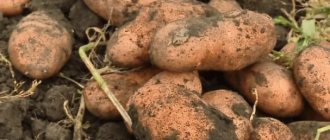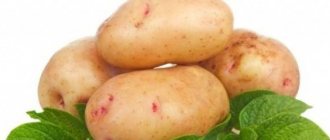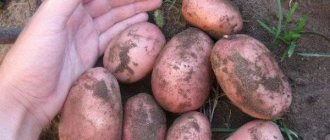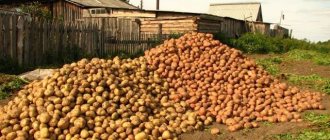Description of the potato variety Lorch
The Lorch potato bush grows tall, branched, and well-leafed. The leaves are medium in size, with a weak section, light green in color. Flowering is long-lasting, flower corollas are red-violet. Berry formation is rare.
The Lorch variety is distinguished by high ecological plasticity, which means the crop is adaptable to various growing conditions. In the characteristics of the Lorch potato variety, it is recommended to grow the plant in loose and moist soils. The variety does not tolerate drought well. It is best to place plantings in areas after growing perennial grasses, legumes, and lupine.
The peculiarities of the variety include the tendency to form additional small tubers from ripened potatoes, which are kept in the soil. The Lorch variety is not resistant to late blight, scab, potato cancer and wireworm. But it is resistant to viral diseases.
Diseases and pests
Hybrids are obtained in laboratory conditions; at the genetic level, they have high immunity to infections and pests. The Lorch potato is a varietal representative of the crop, created by cross-pollination of varieties in the natural environment. Therefore, the plant’s resistance is average.
During the rainy season and low temperatures, Lorch potatoes are affected by late blight. The fungal infection appears in the second half of summer as brown spots on the tops. The disease can destroy the plant, including tubers. For preventive purposes, planting material is treated with manganese and boric acid. At the first signs of the disease, antifungal agents are used: “Exiol”, “Oxihumate”.
Rhizoctonia is a threat to potatoes, a fungal disease that develops at any stage of the growing season. Initially localized on the leaves, the lesion spreads to the tops and root crops. The disease develops quickly, the infection quickly spreads to neighboring plants, and within two weeks it can completely destroy a potato plantation. Signs of rhizoctonia: black spots on tubers, dry areas on the tops. Infected plants are removed from the site and burned. For the next three years, the site is not used for planting nightshade crops. Potatoes are treated with Agat-25 or Baktofit.
The Colorado potato beetle parasitizes crops. If there are few larvae, they are collected by hand and burned. When insects spread massively, the bushes are treated with Actellik or Decis. The root-knot nematode causes great damage to the crop, the parasite attacks the root system, the plant lags behind in development, the leaves dry out, the tops are exposed, the tubers turn out to be small and underdeveloped. It will not be possible to completely destroy the worm and save the plant. There are no remedies against nematodes. The plant is completely removed from the ground, removed from the site, and the planting site is poured with boiling water. Neighboring plants are sprayed with Aldicarb and Heterophos.
Characteristics of Lorch potatoes
The ripening period of Lorch potatoes is medium-late: about 120 days pass from germination to harvest. The crop is characterized by stable productivity. Tubers of high commercial quality, light beige in color, with small eyes, oval in shape. The surface is smooth, slightly flaky.
The weight of one tuber is from 90 to 120 g. The pulp is white, does not darken during cooking, does not soften, and when cooked is crumbly. Contains 15-20% starch and 23% dry matter.
Purpose: table, excellent taste. Suitable for starch processing and mechanized harvesting. Keeping quality is good, retains commercial quality until the new growing season. The variety is resistant to return frosts.
Lorch potatoes are widely zoned, approved for cultivation in the North-Western, Central, Volga-Vyatka, Central Black Earth, North Caucasus, Middle Volga, Lower Volga, Ural and West Siberian regions
Productivity
Lorch potato yield is average. From 1 sq. m harvest 2.5-3.5 kg of potatoes. Under one bush, in case of correct agricultural technology, 15-25 tubers grow. According to the photo and description of the Lorch potato variety, in order to obtain tubers of the declared quality and quantity, it is necessary to maintain soil moisture and fertility.
Advantages and disadvantages
The Lorch variety, bred at the beginning of the last century, is still grown today, despite the emergence of new varieties. This is due to the high plasticity of the crop, which is suitable for growing on various soils, as well as in regions with difficult climates. Cooked tubers have a pleasant aroma and taste. The high starch content allows potatoes to be fried, baked and deep-fried without losing their shape.
The disadvantages of the variety include susceptibility to scab and other common potato diseases. When soil fertility is low, tubers grow unevenly. During the dry period, plants require periodic watering, which is not suitable for areas far from water. One of the characteristics of the variety is also its low yield.
Potato collection and storage
The Lorch potato harvest occurs at the end of August - beginning of September, it depends on when the potatoes were planted, what weather conditions were present, and how well the gardener looked after the plant. The ripening of fruits can be determined by yellowing and drying of the tops, easy separation of tubers from stolons, and the formation of a dense peel on the root crop.
Approximately 10 days before the start of digging, the tops are mowed down, leaving 10-centimeter remains of stems above the ground surface. The harvest is harvested in dry weather. It is better to dig from the side of the rows using a pitchfork. Leave the dug up potatoes in the air for several hours - this is required for the root vegetables to dry out. Then clear the tubers from the soil, discarding sick and damaged ones, and place them in boxes and bags.
Potatoes of this variety have a long shelf life. Storing tubers under the right conditions ensures a long shelf life. Be sure to monitor the temperature in the room - it should not be higher than +2-4 degrees, humidity - no more than 85%. An important condition is ventilation in the room. During storage, fruits are periodically sorted to ensure timely removal of rotten tubers.
Landing rules
Lorch potatoes are planted in previously prepared soil. Vegetable crops need light, rested soil enriched with nutrients.
Before planting, the tubers are sorted and germinated. To protect potatoes from diseases and pests, planting material is sprayed with solutions of fungicides or copper sulfate.
Recommended timing
The recommended time for planting Lorch potatoes is the first and second ten days of May. Depending on the growing region, potatoes are planted only after the soil has warmed up. You can check the readiness of the soil by squeezing a ball of earth, which should crumble and not stick to your hands.
Soil preparation
When preparing a site for planting potatoes, green manure is first planted on it, organic fertilizers are added, and lime is applied if necessary. Fresh manure is not used to enrich the soil.
Advice! Mustard cake is considered a good organic fertilizer for potatoes.
Fertilizer is applied during spring or autumn digging. Mustard cake improves the structure of the soil, cleanses it of various diseases and suppresses their development. Repels wireworms and rodents. It surpasses manure and humus in the composition of useful microelements. Releases beneficial substances gradually, throughout the entire growing season of the plant. The natural composition prevents the accumulation of nitrates in the tubers.
How to plant correctly
Depending on where the site is located, the planting method is chosen. In cold regions and places with close groundwater, Lorch potatoes are recommended to be planted in ridges. In dry areas, smooth planting is used.
Plant according to a scheme where a distance of 35 cm is maintained between tubers in a row and 70 cm between rows. In this case, the planting depth is about 10 cm. For planting, separate holes or a common trench are dug. Tubers in the ground are arranged with sprouts down.
Pros and cons of the variety
Before making a decision to plant one or another potato variety on his plot, each gardener studies its strengths and weaknesses, so that in the fall he can put bags of good tubers in the cellar, and not regret the time spent.
Among the undeniable advantages:
- excellent taste;
- high and stable yield - more than 90%;
- willingness to grow in different climates;
- no special requirements for care and fertilizers;
- suitability for long-term transportation;
- ability for long-term storage;
- increased resistance to diseases and pests;
Among the disadvantages of potatoes:
- difficulty in purchasing seed;
- dependence on moisture and high temperatures;
- susceptibility to certain diseases;
- dependence of yield on cultivation methods.
Features of cultivation
Features of growing Lorch potatoes include maintaining soil moisture and timely harvesting. Otherwise, the culture is similar to general agricultural technology, in which hilling and fertilizing are used as needed.
Watering schedule
The characteristics and reviews of the Lorch potato variety describe its demands on soil moisture. Regular and even watering begins from the moment the sprouts emerge. Watering before the appearance of the vegetative mass leads to the superficial occurrence of tubers. Uniform soil moisture during the period of bud formation is especially important.
Important! Lack of moisture during the flowering period leads to low tuber set, which cannot be compensated for by further watering.
Sudden changes in watering cause defects in the shape of tubers. Sprinkling and installing drip structures are considered good ways to water potatoes.
Loosening, weeding, hilling
Successful cultivation requires timely weeding, loosening and hilling.
During the period from planting to the release of the vegetative mass, weeding helps get rid of weeds that take away nutrition and moisture. Therefore, weed removal begins from the first week of cultivation, combining weeding with loosening.
The soil is also loosened after watering or rain, which is important for tuber respiration and rapid plant growth. It is necessary to loosen not only the soil around the planting, but also the space between the rows.
Hilling is carried out several times a season, which allows you to protect the crop from possible return frosts at the end of spring, and subsequently increase the number of tubers under the potato bush.
Advice! It is best to hill potatoes after watering or rain.
The first addition is carried out when the vegetative mass reaches a height of about 15 cm. The soil from the rows is raked from opposite sides to the bush, creating a small mound at the base of the plant. The second hilling is carried out before flowering begins, and subsequent hillings are carried out if necessary, if the soil has crumbled or the tubers are exposed.
Do I need to feed
Additional fertilizing is applied to potatoes in case of growth retardation and poor development. Microelements such as boron and copper are especially important for culture. Use nitrogen fertilizers with caution and do not use compounds with chlorine.
It is best to use organic fertilizers in liquid form, for example, herbal infusions.
Care
The basics for caring for Lorch potatoes are high-quality watering and hilling.
Irrigation
A significant disadvantage of the Lorch variety is its instability to droughts and lack of watering. If the potatoes experience a lack of water, then the development of root crops will slow down significantly. Therefore, watering should be taken seriously. It is very important not to miss the main watering dates when the plant needs water most:
- 3 weeks after the tops appear.
- Before the formation of inflorescences.
- At the peak of flowering.
- Immediately after the disappearance of the inflorescences.
Normally, one bush uses up to four liters of water. If the crop is grown in arid regions where there is no precipitation, then Lorch potatoes must be watered every 2 weeks.
Watering is best done in the evening or early morning, when there is no solar activity.
Hilling
When growing potatoes, hilling is one of the most important agrotechnical procedures. Hilling helps loosen the soil, gives the crop access to oxygen and moisture, and promotes the appearance of new stolons (due to this, the yield increases by 20-30%).
Hilling is carried out twice:
- When the tops have grown to 15 cm, the first hilling procedure is carried out. It is advisable to hill up the crop after watering or precipitation. It is not recommended to hill up bushes in hot weather.
- The second procedure is carried out after 15-20 days.
Advantages and disadvantages
Pros:
- undemanding to soil types and climate (not counting low resistance to drought);
- excellent taste and tenderness;
- high productivity;
- tubers are located close to the stem in one place;
- resistance to major diseases;
- ease of care;
- keeping quality and transportability;
- universal use, including recyclability.
Minuses:
- vulnerability to droughts and watering requirements;
- instability to scab and potato cancer.
Technology for planting potatoes on the site
The Lorch potato variety is unpretentious in care, but proper planting of the crop and high-quality seed material will ensure high yields.
See also
Description and characteristics of varieties of purple or blue potatoes, beneficial properties
Read
Deadlines
The timing of planting potatoes in open ground directly depends on climatic conditions. In regions with a temperate climate, planting begins in early May. In the southern regions, this work can be carried out a little earlier, and in the northern regions, when the soil warms up to 8 degrees.
Site selection and soil preparation
For planting crops, choose flat, well-lit areas of land. In shaded areas, the crop develops its bushes to the detriment of the ripening of tubers.
Although Lorch potatoes are considered unpretentious to the soil, the more fertile the soil, the better and more productive the harvest will be.
To plant a plant, the soil is prepared in advance; usually such work is carried out in the autumn season. The initially selected area is well loosened. After a couple of weeks, the loosened soil is dug up deeply and organic fertilizers are added. In the spring, before planting, the beds are dug up again, and fertilizers containing nitrogen are added to the soil.
We observe crop rotation
The development, growth and fruiting of a crop directly depends on the predecessors that grew in this soil. Tomatoes, sorghum or sunflowers carry fungi and viruses that are dangerous to potatoes. Therefore, Lorch is not planted after these crops.
Pumpkin, beets, strawberries, carrots, cucumbers and legumes are suitable precursors for planting potatoes. The soil after these vegetables is saturated with useful substances that promote plant development and vegetation.
Important! It is especially good to plant potatoes after cereal crops. Cereal plants are excellent soil health workers who disinfect it from fungi and viruses.
Selection and rejection of planting material
The better the quality of planting material, the greater the chance of getting a large harvest.
The selection of seed requires a serious and careful approach.
- The tubers are selected to be of medium size.
- The surface of the seed is smooth, without visible damage or flaws.
- The tubers are washed from the soil and processed by placing them in a weak solution of potassium permanganate.
- Next, the seed material is placed in small containers for germination.
- During the germination of tubers, they are moistened and turned over as necessary.
- As soon as sprouts appear, the tubers are ready to be planted in open ground.
This potato variety shows low yield if the tubers are cut and divided into several parts when planting. The crop can also be planted without germinating the tubers; in this case, the growing season begins with a delay of 2-3 weeks.
Disembarkation scheme
When planting a crop, its tall bushes are taken into account. The distance between holes should be at least 35-40 cm, between beds from 70 to 80 cm. The variety is tall, with spreading bushes, so they should not interfere with growth and shade each other. Prepared tubers are laid out in pre-dug holes or harrows. Large potatoes are deepened by 8-10 cm, small ones by 6-8 cm.
Important! If there is close groundwater in the soil, it is necessary to raise the beds by 15-20 cm, and only then plant the vegetable.










